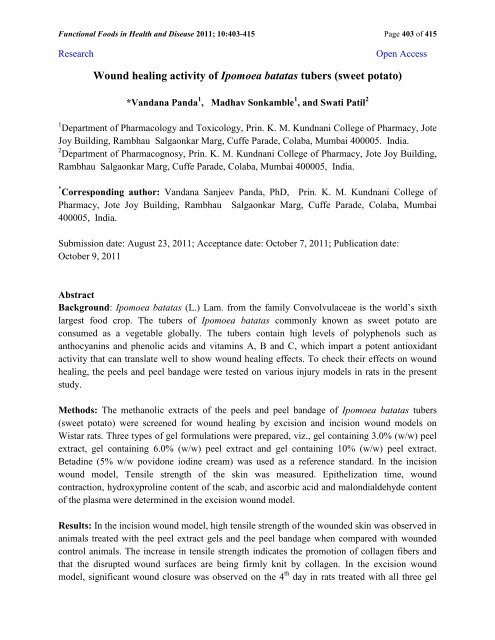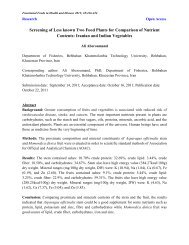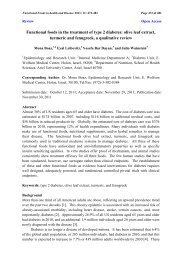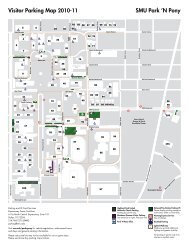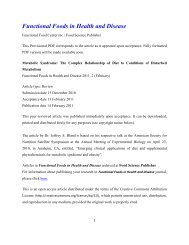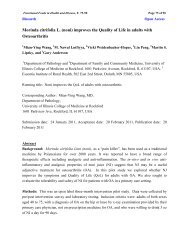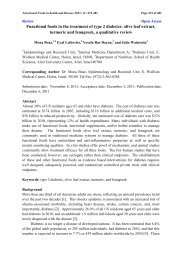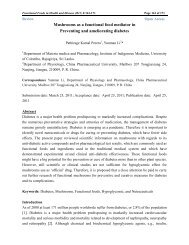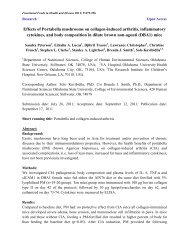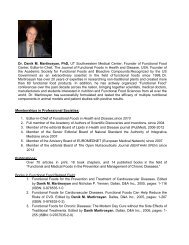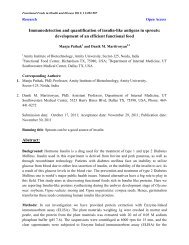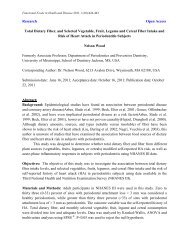Wound healing activity of Ipomoea batatas tubers (sweet potato)
Wound healing activity of Ipomoea batatas tubers (sweet potato)
Wound healing activity of Ipomoea batatas tubers (sweet potato)
Create successful ePaper yourself
Turn your PDF publications into a flip-book with our unique Google optimized e-Paper software.
Functional Foods in Health and Disease 2011; 10:403-415 Page 403 <strong>of</strong> 415<br />
Research Open Access<br />
<strong>Wound</strong> <strong>healing</strong> <strong>activity</strong> <strong>of</strong> <strong>Ipomoea</strong> <strong>batatas</strong> <strong>tubers</strong> (<strong>sweet</strong> <strong>potato</strong>)<br />
*Vandana Panda 1 , Madhav Sonkamble 1 , and Swati Patil 2<br />
1 Department <strong>of</strong> Pharmacology and Toxicology, Prin. K. M. Kundnani College <strong>of</strong> Pharmacy, Jote<br />
Joy Building, Rambhau Salgaonkar Marg, Cuffe Parade, Colaba, Mumbai 400005. India.<br />
2 Department <strong>of</strong> Pharmacognosy, Prin. K. M. Kundnani College <strong>of</strong> Pharmacy, Jote Joy Building,<br />
Rambhau Salgaonkar Marg, Cuffe Parade, Colaba, Mumbai 400005, India.<br />
* Corresponding author: Vandana Sanjeev Panda, PhD, Prin. K. M. Kundnani College <strong>of</strong><br />
Pharmacy, Jote Joy Building, Rambhau Salgaonkar Marg, Cuffe Parade, Colaba, Mumbai<br />
400005, India.<br />
Submission date: August 23, 2011; Acceptance date: October 7, 2011; Publication date:<br />
October 9, 2011<br />
Abstract<br />
Background: <strong>Ipomoea</strong> <strong>batatas</strong> (L.) Lam. from the family Convolvulaceae is the world’s sixth<br />
largest food crop. The <strong>tubers</strong> <strong>of</strong> <strong>Ipomoea</strong> <strong>batatas</strong> commonly known as <strong>sweet</strong> <strong>potato</strong> are<br />
consumed as a vegetable globally. The <strong>tubers</strong> contain high levels <strong>of</strong> polyphenols such as<br />
anthocyanins and phenolic acids and vitamins A, B and C, which impart a potent antioxidant<br />
<strong>activity</strong> that can translate well to show wound <strong>healing</strong> effects. To check their effects on wound<br />
<strong>healing</strong>, the peels and peel bandage were tested on various injury models in rats in the present<br />
study.<br />
Methods: The methanolic extracts <strong>of</strong> the peels and peel bandage <strong>of</strong> <strong>Ipomoea</strong> <strong>batatas</strong> <strong>tubers</strong><br />
(<strong>sweet</strong> <strong>potato</strong>) were screened for wound <strong>healing</strong> by excision and incision wound models on<br />
Wistar rats. Three types <strong>of</strong> gel formulations were prepared, viz., gel containing 3.0% (w/w) peel<br />
extract, gel containing 6.0% (w/w) peel extract and gel containing 10% (w/w) peel extract.<br />
Betadine (5% w/w povidone iodine cream) was used as a reference standard. In the incision<br />
wound model, Tensile strength <strong>of</strong> the skin was measured. Epithelization time, wound<br />
contraction, hydroxyproline content <strong>of</strong> the scab, and ascorbic acid and malondialdehyde content<br />
<strong>of</strong> the plasma were determined in the excision wound model.<br />
Results: In the incision wound model, high tensile strength <strong>of</strong> the wounded skin was observed in<br />
animals treated with the peel extract gels and the peel bandage when compared with wounded<br />
control animals. The increase in tensile strength indicates the promotion <strong>of</strong> collagen fibers and<br />
that the disrupted wound surfaces are being firmly knit by collagen. In the excision wound<br />
model, significant wound closure was observed on the 4 th day in rats treated with all three gel
Functional Foods in Health and Disease 2011; 10:403-415 Page 404 <strong>of</strong> 415<br />
formulations when compared with the wounded control rats. A significant increase in<br />
hydroxyproline and ascorbic acid content in the gel-treated animals and a significant decrease in<br />
malondialdehyde content in the animals treated with gel as well as peel bandage was observed<br />
when compared with the wounded control animals.<br />
Conclusion: It may be concluded that the peels <strong>of</strong> <strong>Ipomoea</strong> <strong>batatas</strong> <strong>tubers</strong> possess a potent<br />
wound <strong>healing</strong> <strong>activity</strong>, which may be due to an underlying antioxidant mechanism.<br />
Key Words: Sweet <strong>potato</strong> peels, excision wound, incision wound, wound <strong>healing</strong><br />
BACKGROUND<br />
The skin is the largest organ <strong>of</strong> the body that acts as a barrier against external agents. The loss <strong>of</strong><br />
skin tissue integrity can cause lesions or illnesses that could be fatal [1]. <strong>Wound</strong>s are inescapable<br />
events <strong>of</strong> life; wounds may arise due to physical, chemical or microbial agents and wound<br />
<strong>healing</strong> has been one <strong>of</strong> the earliest medical problems.<br />
<strong>Wound</strong> <strong>healing</strong> is the process <strong>of</strong> repair that follows injury to the skin and other s<strong>of</strong>t<br />
tissues. Following injury, an inflammatory response occurs and the cells below the dermis begin<br />
to increase collagen production [2]. Later, the epithelial tissue is regenerated. <strong>Wound</strong> <strong>healing</strong><br />
consists <strong>of</strong> an orderly progression <strong>of</strong> events that re-establish the integrity <strong>of</strong> the damaged tissue<br />
[1]. There are three main phases <strong>of</strong> wound <strong>healing</strong> viz., inflammatory, proliferative and<br />
remodeling phase. The inflammatory phase begins immediately after injury with<br />
vasoconstriction that favors and releases inflammatory mediators. The proliferative phase is<br />
characterized by granulation tissue formation mainly by fibroblasts and angiogenesis. The<br />
remodeling phase is characterized by reformulation and improvement in the components <strong>of</strong> the<br />
collagen fiber that increases the tensile strength.<br />
<strong>Ipomoea</strong> <strong>batatas</strong> (L.) Lam. from the family Convolvulaceae is the world’s sixth largest<br />
food crop which is widely grown in tropical, subtropical and warm temperate regions [3]. The<br />
tuber <strong>of</strong> <strong>Ipomoea</strong> <strong>batatas</strong> is commonly known as <strong>sweet</strong> <strong>potato</strong>. It is also called kamote, lapni,<br />
yams and tugi in various parts <strong>of</strong> the world. The boiled <strong>tubers</strong> are consumed as a vegetable<br />
globally. The tuber is <strong>of</strong>ten long and tapered and the skin may be red, purple, or brown and white<br />
in color. The flesh may be white, yellow, orange or purple. The I. <strong>batatas</strong> plant has been used<br />
extensively in traditional medicines for various ailments [4, 5].<br />
Current methods used to treat wounds include debridement, irrigation, use <strong>of</strong> antiseptics,<br />
antibiotic and corticosteroid therapy, and tissue grafts [6]. However, these methods are<br />
associated with unwanted side effects such as potential for bacterial resistance, bleeding, tissue<br />
damage, contact dermatitis and delay in wound <strong>healing</strong>.<br />
Another interesting practice to treat a wound is the use <strong>of</strong> <strong>potato</strong> peel bandage as an<br />
occlusive dressing [7]. This serves the dual purpose <strong>of</strong> protecting the wound from external<br />
damage as well as providing a therapeutic benefit due to the presence <strong>of</strong> wound <strong>healing</strong><br />
constituents. There has been no research regarding the usage <strong>of</strong> <strong>sweet</strong> <strong>potato</strong> peels for treatment<br />
<strong>of</strong> wounds. Thus, research on the therapeutic use <strong>of</strong> <strong>sweet</strong> <strong>potato</strong> peels for wound treatment will<br />
add to the development <strong>of</strong> newer wound <strong>healing</strong> agents.
Functional Foods in Health and Disease 2011; 10:403-415 Page 405 <strong>of</strong> 415<br />
The <strong>tubers</strong> and skin <strong>of</strong> <strong>Ipomoea</strong> <strong>batatas</strong> contain high levels <strong>of</strong> polyphenols, such as<br />
anthocyanins and phenolic acids and are also a good source <strong>of</strong> vitamins A, B and C, iron,<br />
calcium and phosphorus [8]. A potent antioxidant <strong>activity</strong> due to the presence <strong>of</strong> antioxidants<br />
such as beta carotene, anthocyanins, caffeoyldaucic acid and caffeoylquinic acid derivatives can<br />
translate well to show wound <strong>healing</strong> effects [9, 10]. Hence, testing <strong>of</strong> the wound <strong>healing</strong><br />
potential <strong>of</strong> the peels <strong>of</strong> <strong>sweet</strong> <strong>potato</strong> is proposed.<br />
The present research was undertaken to evaluate the wound <strong>healing</strong> <strong>activity</strong> <strong>of</strong> the peels<br />
<strong>of</strong> <strong>Ipomoea</strong> <strong>batatas</strong> <strong>tubers</strong> (<strong>sweet</strong> <strong>potato</strong>).<br />
MATERIALS AND METHODS:<br />
Plant material<br />
Fresh <strong>tubers</strong> <strong>of</strong> <strong>sweet</strong> <strong>potato</strong> were collected from Colaba market, Colaba, Mumbai and<br />
authenticated at the Blatter herbarium, St. Xavier College, Mumbai (Accession no. 47280).<br />
Whole <strong>tubers</strong> were washed with distilled water to remove the exudates from their surfaces.<br />
Drugs and chemicals<br />
Thiobarbituric acid (TBA), trichloroacetic acid (TCA) and L-hydroxyproline, were obtained<br />
from Himedia Laboratories, Mumbai, India. Ascorbic acid and 2,4-dinitrophenyl hydrazine were<br />
obtained from Merck Ltd., Mumbai. All other chemicals were obtained from local sources and<br />
were <strong>of</strong> analytical grade.<br />
Extraction<br />
Peel Extract (PE): The peels <strong>of</strong> <strong>sweet</strong> <strong>potato</strong> <strong>tubers</strong> were removed, dried at 60 0 C and extracted<br />
with methanol.<br />
Peel Bandage (PB): For making the bandage, <strong>tubers</strong> were boiled and peels were separated.<br />
Approximately 1 g <strong>of</strong> wet peels was used. With the aid <strong>of</strong> cotton and gauze, bandages <strong>of</strong> the<br />
peels were prepared and applied as such.<br />
Preparation <strong>of</strong> gels [11, 12]<br />
Carbopol 974P NF (0.25 g) was dispersed in 22 ml <strong>of</strong> distilled water and mixed by stirring<br />
continuously in a magnetic stirrer at 800 rpm for 1 h. Glycerol (1.25 g) was added to the mixture<br />
under continuous stirring. The mixture was neutralized by drop-wise addition <strong>of</strong> 50 %<br />
triethanolamine. Mixing was continued until a transparent gel was formed. Three types <strong>of</strong> gel<br />
formulations were prepared viz., gel containing 3.0 % (w/w) peel extract, gel containing 6.0 %<br />
(w/w) peel extract and gel containing 10 % (w/w) peel extract.<br />
Experimental animals<br />
Wistar albino rats (150-200 g) <strong>of</strong> either sex were used. They were housed in clean polypropylene<br />
cages under standard conditions <strong>of</strong> humidity (50 ± 5 %), temperature (25±2°C) and light (12 h<br />
light/12 h dark cycle) and fed with a standard diet (Amrut laboratory animal feed, Pune, India)<br />
and water ad libitum. All animals were handled with humane care. Experimental protocols were<br />
reviewed and approved by the Institutional Animal Ethics Committee (Animal House<br />
Registration No.25/1999/CPCSEA) and conform to the Indian National Science Academy<br />
Guidelines for the Use and Care <strong>of</strong> Experimental Animals in Research.
Functional Foods in Health and Disease 2011; 10:403-415 Page 406 <strong>of</strong> 415<br />
Acute toxicity study (ALD50)<br />
Acute toxicity studies were carried out on Wistar rats by the topical route at dose levels up to<br />
2000 mg/kg <strong>of</strong> the peel extract <strong>of</strong> <strong>Ipomoea</strong> <strong>batatas</strong> <strong>tubers</strong>, as per the OECD- guidelines No.402.<br />
<strong>Wound</strong> <strong>healing</strong> <strong>activity</strong><br />
Adult Wistar albino rats <strong>of</strong> either sex weighing 180-200 g were used for the study. The effects <strong>of</strong><br />
the peel extract and peel bandage were evaluated on excision and incision wound models in rats.<br />
Betadine (5% w/w povidone iodine cream) was used as a standard drug for comparing the wound<br />
<strong>healing</strong> potential <strong>of</strong> the extract in different animal models.<br />
Excision wound model [13]<br />
Animals, after acclimatization (6–7 days) in the animal quarters, were randomly divided into six<br />
groups <strong>of</strong> six animals each and treated in the following way:<br />
Group I – <strong>Wound</strong>ed control (untreated) group<br />
Group II – Peel bandage group<br />
Group III – Test treatment group (3% peel extract gel)<br />
Group IV – Test treatment group (6% peel extract gel)<br />
Group V– Test treatment group (10% peel extract gel)<br />
Group VI– Standard treatment group (Betadine 5% w/w povidone iodine cream)<br />
Animals were anaesthetized by open mask method using ether before wound creation.<br />
The particular skin area was shaved 1 day prior to the experiment. A full thickness <strong>of</strong> the<br />
excision wound <strong>of</strong> circular area (approx. 500 mm 2 ) and 2 mm depth was made on the shaved<br />
back <strong>of</strong> the rats. The wound was left undressed to the open environment. The peel extract gel and<br />
peel bandage and the standard Betadine (5% w/w povidone iodine cream) were topically applied<br />
twice a day to the respective groups (Groups II to VI) till the wound was completely healed.<br />
<strong>Wound</strong> closure was studied by tracing the raw wound using transparent paper and a permanent<br />
marker on every 4 th day for 16 days. <strong>Wound</strong> area was measured by retracing the wound on a<br />
millimeter scale graph paper. The period <strong>of</strong> epithelization was calculated as the number <strong>of</strong> days<br />
required for falling <strong>of</strong>f <strong>of</strong> the dead tissue remnants without any residual raw wound. On the 10 th<br />
day, the scab was removed and used for hydroxyproline estimation and the plasma was separated<br />
from blood for malondialdehyde (MDA) and ascorbic acid assays.<br />
Collection <strong>of</strong> granulation tissue:<br />
Granulation tissues from the wounded control and treated rats were collected, washed well in<br />
cold saline (0.9% w/v NaCl) and lyophilized for L- Hydroxyproline estimation [14].<br />
L-Hydroxyproline estimation:<br />
On the 10 th day, granulation tissue was isolated from each group <strong>of</strong> rats for estimation <strong>of</strong> the<br />
hydroxyproline content. Hydroxyproline was measured using the method <strong>of</strong> Bergman & Loxley<br />
as follows [15].<br />
Preparation <strong>of</strong> standard curve:<br />
Stock solution <strong>of</strong> 100 µg/ml <strong>of</strong> hydroxyproline was prepared in 0.001M aqueous hydrochloric<br />
acid.
Functional Foods in Health and Disease 2011; 10:403-415 Page 407 <strong>of</strong> 415<br />
Appropriate amounts <strong>of</strong> aliquots <strong>of</strong> the stock solution <strong>of</strong> hydroxyproline were used to get a<br />
concentration range from 10-100 µg/ml (10, 20, 40, 60, 80, and 100 µg/ml).<br />
To 2 ml <strong>of</strong> the above solutions, 1 ml <strong>of</strong> the oxidant solution [1ml <strong>of</strong> 7 % w/v aqueous<br />
Chloramine T solution and 4ml <strong>of</strong> acetate citrate buffer (pH-6)] was added and the solutions<br />
were mixed and allowed to stand for 4±1 minutes at a room temperature (25-30 0 C).<br />
The color was developed by adding 13 ml <strong>of</strong> the Ehrlich reagent to each solution. The solutions<br />
were mixed well, heated for 25 minutes at 60 0 C ± 0.2 0 C, cooled for 2 to 3 minutes in running tap<br />
water and then transferred to 50 ml volumetric flasks and diluted up to the mark with<br />
isopropanol.<br />
The absorbance <strong>of</strong> the color was measured at 558 nm against reagent blank.<br />
Extraction <strong>of</strong> hydroxyproline from the scab:<br />
A. Preparation <strong>of</strong> hydrolysate<br />
The scab (about 250 mg) removed from the excision wound <strong>of</strong> each animal was dried in an oven<br />
at 60 0 C for 24 h and 100 mg was placed in a sealed tube containing 2 ml <strong>of</strong> 6 N hydrochloric<br />
acid. The scab was hydrolyzed by heating the sealed tube at 110 0 C for 4 h; the hydrolysate, thus<br />
obtained was neutralized with 10 N sodium hydroxide.<br />
B. Estimation <strong>of</strong> hydroxyproline in the scab<br />
The above hydrolysate (2 ml) was transferred to a 50 ml test tube and the color was developed<br />
following the procedure as described earlier. The concentration <strong>of</strong> hydroxyproline in the scabs<br />
was determined by extrapolating from the standard curve and was expressed as µg <strong>of</strong> Lhydroxyproline<br />
/100 mg protein.<br />
Collection <strong>of</strong> blood<br />
Blood samples were collected from the retro-orbital plexus <strong>of</strong> the eye in sterile eppendorfs rinsed<br />
with EDTA. Plasma was separated for malondialdehyde and ascorbic acid estimation [14].<br />
Malondialdehyde (MDA) estimation:<br />
Malondialdehyde was measured using the method <strong>of</strong> Yagi et al [16]. To 0.1 ml <strong>of</strong> the plasma, 0.9<br />
ml <strong>of</strong> 10% TCA and 2 ml <strong>of</strong> 0.67% TBA reagent were added and kept in boiling water bath for<br />
20 min. The tubes were cooled after centrifugation and the absorbance <strong>of</strong> the supernatant was<br />
read at 532 nm. The MDA concentration was calculated from the standard graph. The results<br />
were expressed as nmol <strong>of</strong> MDA/mg protein using molar extinction coefficient <strong>of</strong> the<br />
chromophore (1.56 × 10 -5 /M/cm) and 1,1,3,3-tetraethoxypropane as standard<br />
Ascorbic acid estimation:<br />
Ascorbic acid was measured using the method <strong>of</strong> Omayer et al [17]. To 0.5 ml <strong>of</strong> plasma, 0.5 ml<br />
<strong>of</strong> ice cold 10% TCA was added, mixed thoroughly and centrifuged for 20 min at 3500 g.<br />
Supernatant (0.5 ml) was mixed well with 0.1ml <strong>of</strong> DTC reagent (2,4-dinitrophenyl hydrazinethiourea-CuSO4<br />
reagent) and incubated at 37 0 C for 3h. Then, 0.75ml <strong>of</strong> ice cold 65% H2SO4 was<br />
added, the reaction mixture was allowed to stand at room temperature for 30 min and the yellow<br />
color developed was read at 520nm. Standard curve was prepared by using various aliquots from<br />
the ascorbic acid stock solution. The unknown ascorbic acid concentration was obtained by<br />
extrapolation from the standard curve. The results were expressed as g/dL <strong>of</strong> ascorbic acid.
Functional Foods in Health and Disease 2011; 10:403-415 Page 408 <strong>of</strong> 415<br />
Incision wound model [18]<br />
Animals, after acclimatization (6–7 days) in the animal quarters, were randomly divided into five<br />
groups <strong>of</strong> six animals each and treated in the following way:<br />
Group I – <strong>Wound</strong>ed control (untreated) group<br />
Group II – Peel bandage group<br />
Group III – Test treatment group (3% peel extract gel)<br />
Group IV – Test treatment group (6% peel extract gel)<br />
Group V– Standard treatment group (Betadine 5% w/w povidone iodine cream)<br />
Animals were anaesthetized by open mask method with anesthetic ether before wound creation.<br />
The particular skin area was shaved 1 day prior to the experiment. Incision wounds <strong>of</strong> about 6<br />
cm in length and 2mm in depth were made with sterile scalpel on the shaved back <strong>of</strong> the rats.<br />
The parted skin was held together and sutured with surgical thread at 1 cm intervals using a<br />
curved needle (no.11). The continuous thread on both wound edges was tightened for good<br />
closure <strong>of</strong> the wounds. The wounds <strong>of</strong> animals in the respective groups (Groups II to V) were<br />
treated with the topical applications <strong>of</strong> peel extract gel and peel bandage and standard betadine<br />
for a period <strong>of</strong> 10 days. When wounds were healed thoroughly, the sutures were removed on the<br />
8 th post-wounding day. Animals were humanely sacrificed using ether on the 10 th day and the<br />
tensile strength (weight in grams required to break open the wound/skin) was measured<br />
immediately by a Tensiometer.<br />
Tensiometer: [19]<br />
The tensiometer consists <strong>of</strong> a 6 x 12 inch wooden board with one arm <strong>of</strong> 4 inch length, fixed on<br />
each side <strong>of</strong> the possible longest distance <strong>of</strong> the board. The board was placed at the edge <strong>of</strong> a<br />
table. A pulley with a bearing was mounted on the top <strong>of</strong> one arm. An alligator clamp with 1 cm<br />
width was tied on the tip <strong>of</strong> the other arm by a fishing line in such a way that the clamp could<br />
reach the middle <strong>of</strong> the board. Another alligator clamp was tied on a longer fishing line with a<br />
weighing pan on the other end.<br />
Determination <strong>of</strong> tensile strength: [19]<br />
Sutures were removed on the 8 th day after wounding and tensile strength was measured on the<br />
10 th day. The peel extract gels, peel bandage and the standard were applied topically throughout<br />
the period, once daily for 9 days. On the 10 th day, the rats were again anaesthetized and each rat<br />
was placed on the middle <strong>of</strong> the board. The clamps were then carefully attached to the skin on<br />
the opposite sides <strong>of</strong> the wound at a distance <strong>of</strong> 0.5 cm from the wound. The longer pieces <strong>of</strong> the<br />
fishing line were placed on the pulley and finally on to the weighing pan and weights were added<br />
until the wound began to open. The amount <strong>of</strong> weight required to break the wound is considered<br />
as a direct measure <strong>of</strong> the tensile strength <strong>of</strong> the wound. The tensile strength <strong>of</strong> the wounds <strong>of</strong> all<br />
the treatment group animals was compared with that <strong>of</strong> the wounded control group animals.<br />
Statistical analysis: The results <strong>of</strong> wound <strong>healing</strong> <strong>activity</strong> were expressed as mean ± SEM.<br />
Results were statistically analyzed using one-way ANOVA, followed by the Tukey–Kramer post<br />
test for individual comparisons. P
Functional Foods in Health and Disease 2011; 10:403-415 Page 409 <strong>of</strong> 415<br />
RESULTS:<br />
Excision wound model<br />
<strong>Wound</strong> contraction<br />
<strong>Wound</strong> contraction is an important parameter used to assess wound <strong>healing</strong>. The percentage<br />
wound contraction was determined using the following formula [20]:<br />
Percent wound contraction = Healed area X 100<br />
Total wound area<br />
<strong>Wound</strong> area was measured by tracing the wound margin using a transparent paper at a 4-day<br />
interval and the healed area was calculated by subtracting from the original wound area [20]. On<br />
day 4, the wound contractions <strong>of</strong> all treated groups were found to be significantly higher<br />
[standard (P < 0.001), 10% peel extract gel (P < 0.001), 6% peel extract gel (P < 0.01), 3% peel<br />
extract gel (P < 0.01), and peel bandage (P < 0.05)] than the contraction in the wounded control<br />
group. Also, on the 8 th , 12 th and 16 th days, the wound contractions <strong>of</strong> all treated groups were<br />
found to be significantly higher than that in the wounded control group.<br />
On the 18 th day, the wound treated with 10% peel extract gel had completely healed<br />
while the wound treated with the standard (5% w/w povidone iodine) had also reached the<br />
complete <strong>healing</strong> stage. On the 19 th day, the standard treated group healed 100%, 6% peel extract<br />
gel treated group healed 95.32%, 3% peel extract gel treated group healed 90.78% and peel<br />
bandage treated group healed 88.07%. It was also observed that the epithelization period <strong>of</strong> the<br />
treatment and standard groups was less in comparison with the wounded control group (Table 1).<br />
Table 1. Effect <strong>of</strong> peel extract gel and peel bandage <strong>of</strong> <strong>Ipomoea</strong> <strong>batatas</strong> <strong>tubers</strong> on wound<br />
contraction and epithelization in the excision wound model in Wistar rats<br />
Groups/ Doses % <strong>Wound</strong> Contraction<br />
<strong>Wound</strong>ed<br />
Control<br />
Peel Bandage<br />
(1gm)<br />
Peel extract gel<br />
(3% w/w)<br />
Peel extract gel<br />
(6% w/w)<br />
Peel extract gel<br />
(10% w/w)<br />
Povidone iodine<br />
cream (5%w/w)<br />
4 th day 8 th day 12 th day 16 th day Period <strong>of</strong> Epithelization<br />
(Days)<br />
5.65 ± 1.43 25.02 ± 0.13 51.92 ± 0.10 78.02 ± 0.20 28<br />
11.48 ± 1.43 a 37.71 ± 0.21 a 63.57 ± 2.5 a 88.07 ± 0.82 a 25<br />
12.76 ± 0.25 b<br />
36.62 ± 0.31 b 68.61 ± 2.52 b 90.78 ± 0.36 b 23<br />
13.29± 0.44 b 39.51± 0.21 b 73.35 ± 0.49 b 95.32 ±0.25 c 21<br />
14.39 ± 1.04 c 50.91± 0.21 c 79.82 ±0.51 c 97.04 ± 0.12 c 18<br />
13.84 ± 1.37 b 44.44 ± 0.11 b 78.02± 2.6 c 96.35 ± 0.15 c 19<br />
Values are Mean ± SEM from 6 animals in each group.<br />
a P value< 0.05 when experimental groups compared with wounded control group.<br />
b P value< 0.01 when experimental groups compared with wounded control group.<br />
c P value< 0.001 when experimental groups compared with wounded control group.
Functional Foods in Health and Disease 2011; 10:403-415 Page 410 <strong>of</strong> 415<br />
Biochemical parameters<br />
Hydroxyproline<br />
In our study, the hydroxyproline content was found to be significantly increased in standard (P <<br />
0.001), 10% peel extract gel (P < 0.001), 6% peel extract gel (P < 0.01), and 3% peel extract gel<br />
(P < 0.05) when compared with the wounded control group. However, the peel bandage group<br />
did not show significant increase in hydroxyproline content when compared with the wounded<br />
control group (Table 2). An increase in hydroxyproline content indicates increased collagen<br />
synthesis, thus, enhanced wound <strong>healing</strong>.<br />
Table 2. Effect <strong>of</strong> peel extract gel and peel bandage <strong>of</strong> <strong>Ipomoea</strong> <strong>batatas</strong> <strong>tubers</strong> on L-hydroxy<br />
proline, malondialdehyde and ascorbic acid content in the excision wound model in Wistar<br />
rats<br />
Groups L-Hydroxy Proline<br />
(mg/g tissue)<br />
<strong>Wound</strong>ed control<br />
group<br />
Malondialdehyde<br />
(Lipid Peroxidation) nmoles<br />
<strong>of</strong> MDA/mg protein<br />
Ascorbic acid (gm/dl )<br />
9.221±0.246 0.806±0.048 2.590±0.252<br />
Peel bandage group 11.036±0.379 0.606 ±0.029 b 4.118±0.153<br />
Peel extract gel<br />
(3% w/w)<br />
Peel extract gel<br />
(6% w/w)<br />
Peel extract gel<br />
(10% w/w)<br />
Povidone iodine<br />
cream (5%w/w)<br />
12.847±0.756 a 0.595 ±0.049 b 4.377±0.259 a<br />
13.15±0.724 b 0.452 ±0.004 c 4.618±0.396 b<br />
14.633±0.920 c 0.35±0.013 c 5.886±0.322 c<br />
14.47±0.915 c 0.404±0.025 c 5.736±0.441 c<br />
Values are Mean ± SEM from 6 animals in each group.<br />
a P value< 0.05 when experimental groups compared with wounded control group.<br />
b P value< 0.01 when experimental groups compared with wounded control group.<br />
c P value< 0.001 when experimental groups compared with wounded control group.<br />
Malondialdehyde<br />
The malondialdehyde content was found to be significantly decreased in standard (P < 0.001),<br />
10% peel extract gel (P < 0.001), 6% peel extract gel (P < 0.001), 3% peel extract gel (P < 0.01)<br />
and peel bandage (P < 0.01) groups when compared with the wounded control group (Table 2),
Functional Foods in Health and Disease 2011; 10:403-415 Page 411 <strong>of</strong> 415<br />
thus, demonstrating an anti-lipid peroxidative effect <strong>of</strong> the I. <strong>batatas</strong> extract, augmenting wound<br />
<strong>healing</strong>.<br />
Ascorbic acid<br />
In our study, the ascorbic acid content was found to be significantly increased in standard (P <<br />
0.001), 10% peel extract gel (P < 0.001), 6% peel extract gel (P < 0.01), and 3% peel extract gel<br />
(P < 0.05) groups when compared with the wounded control group. However, the peel bandage<br />
group did not show a significant increase in ascorbic acid content when compared with the<br />
wounded control group (Table 2). An increased ascorbic acid content in the peel extract geltreated<br />
groups is reflective <strong>of</strong> a good antioxidant status and thus, improved wound <strong>healing</strong>.<br />
Incision wound model<br />
Tensile strength<br />
In our study, the tensile strength <strong>of</strong> skin was found to be significantly increased in standard (P <<br />
0.001), 6% peel extract gel (P < 0.001), 3% peel extract gel (P < 0.01) and peel bandage (P <<br />
0.05) groups when compared with the wounded control group <strong>of</strong> animals (Table 3). The increase<br />
in tensile strength <strong>of</strong> treated wounds may be due to an increase in collagen concentration and<br />
stabilization <strong>of</strong> the fibers facilitating wound <strong>healing</strong>.<br />
Table 3. Effect <strong>of</strong> peel extract gel and peel bandage <strong>of</strong> <strong>Ipomoea</strong> <strong>batatas</strong> <strong>tubers</strong> on tensile<br />
strength in the incision wound model in Wistar rats.<br />
Groups Tensile strength (g)<br />
<strong>Wound</strong>ed control group 310 ±2.887<br />
Peel bandage group 355 ±5.701 a<br />
Peel extract gel (3% w/w) 379 ±8.276 b<br />
Peel extract gel (6% w/w ) 443 ±10.440 c<br />
Povidone iodine cream (5%w/w) 430 ±14.72 c<br />
Values are Mean ± SEM from 6 animals in each group.<br />
a P value< 0.05 when experimental groups compared with wounded control group.<br />
b P value< 0.01 when experimental groups compared with wounded control group.<br />
c P value< 0.001 when experimental groups compared with wounded control group.<br />
DISCUSSION<br />
The wound <strong>healing</strong> process consists <strong>of</strong> different phases such as granulation, collagenation,<br />
collagen maturation and scar maturation which are concurrent but independent <strong>of</strong> each other<br />
[20]. Hence, in this study two different models were used to assess the effect <strong>of</strong> peels <strong>of</strong> <strong>Ipomoea</strong><br />
<strong>batatas</strong> <strong>tubers</strong> (<strong>sweet</strong> <strong>potato</strong>) on various phases. The results <strong>of</strong> the present study showed that the<br />
peels <strong>of</strong> <strong>sweet</strong> <strong>potato</strong> possessed a definite pro-<strong>healing</strong> action.
Functional Foods in Health and Disease 2011; 10:403-415 Page 412 <strong>of</strong> 415<br />
<strong>Wound</strong> contraction, the process <strong>of</strong> shrinkage <strong>of</strong> area <strong>of</strong> the wound depends on the<br />
reparative abilities <strong>of</strong> the tissue, type and extent <strong>of</strong> the damage and general state <strong>of</strong> the health <strong>of</strong><br />
the tissue [21]. In the excision wound model, the extract <strong>of</strong> the peels and peel bandage <strong>of</strong> the<br />
<strong>Ipomoea</strong> <strong>batatas</strong> <strong>tubers</strong> showed significant increase in percentage closure <strong>of</strong> the wounds by<br />
enhanced epithelization. This enhanced epithelization may be due to the antioxidant effect <strong>of</strong> the<br />
peels, which augments collagen synthesis.<br />
Collagen, the major protein <strong>of</strong> the extracellular matrix, is the component that ultimately<br />
liberates free hydroxyproline and its peptides [22]. The measurement <strong>of</strong> hydroxyproline can be<br />
used as an index for collagen turnover. Increase in hydroxyproline content indicates increased<br />
collagen synthesis which in turn leads to enhanced wound <strong>healing</strong>. The hydroxyproline content<br />
in wounds treated with hydrogel containing peel extracts and peel bandage was found to be<br />
higher than that in the wounded control animals.<br />
An elevation in the levels <strong>of</strong> end products <strong>of</strong> lipid peroxidation in wounded control rats<br />
was observed. The increase in MDA levels suggests enhanced peroxidation and failure <strong>of</strong> the<br />
antioxidant defense mechanisms to prevent the formation <strong>of</strong> excessive free radicals [23].<br />
Treatment with the peel extract gel and peel bandage significantly reversed these changes.<br />
Hence, it is likely that the mechanism <strong>of</strong> wound <strong>healing</strong> <strong>of</strong> the peels <strong>of</strong> <strong>Ipomoea</strong> <strong>batatas</strong> <strong>tubers</strong> is<br />
due to its ability to scavenge free radicals.<br />
Ascorbic acid is a known antioxidant that possesses potent free radical scavenging <strong>activity</strong> and<br />
inhibits lipid peroxidation [9]. In the present study, the ascorbic acid level was found to be higher<br />
in the test treatment groups than the wounded control group <strong>of</strong> rats, and hence a decline in lipid<br />
peroxidation was observed, indicating an antioxidant effect. Thus, free radical scavenging effect<br />
<strong>of</strong> the peels and peel extracts <strong>of</strong> <strong>Ipomoea</strong> <strong>batatas</strong> (in a dose related manner) might be one <strong>of</strong> the<br />
most important components <strong>of</strong> wound <strong>healing</strong>.<br />
The tensile strength <strong>of</strong> a wound is determined by the rate <strong>of</strong> collagen synthesis and more<br />
so, by the maturation process where there is a covalent binding <strong>of</strong> collagen fibrils through inter<br />
and intra molecular cross linking [24]. In the incision wound study, there was a significant<br />
increase in tensile strength <strong>of</strong> the 10-day old wound due to treatment with the peel extract gel,<br />
peel bandage and the standard drug. The tensile strength <strong>of</strong> the standard drug (Povidone iodine<br />
cream (5%w/w)) and the 6% peel extract gel treated groups was comparable but much greater<br />
than that <strong>of</strong> the peel bandage group. The increase in tensile strength <strong>of</strong> treated wounds may be<br />
due to an increase in collagen concentration and stabilization <strong>of</strong> the fibers facilitating wound<br />
<strong>healing</strong>. This increase in collagen synthesis may be due to the antioxidant effect <strong>of</strong> the peels,<br />
which enhances wound <strong>healing</strong><br />
Phytochemical investigations <strong>of</strong> the peel extract showed the presence <strong>of</strong> high levels <strong>of</strong><br />
polyphenols (anthocyanins and phenolic acids) and sesquiterpenoids (6-myoporol, 4hydroxydehydromyoporone<br />
and ipomeamarone) [25, 26]. Anthocyanins, phenolic acids<br />
(caffeoylquinic acid derivatives like chlorogenic, dicaffeoylquinic, and tricaffeoylquinic acids)<br />
and β-carotene have been documented to possess potent antioxidant and free radical scavenging<br />
effect, which is believed to be one <strong>of</strong> the most important components <strong>of</strong> wound <strong>healing</strong> [25, 27].<br />
Thus, the enhanced wound <strong>healing</strong> may be due to this free radical scavenging effect. The wound
Functional Foods in Health and Disease 2011; 10:403-415 Page 413 <strong>of</strong> 415<br />
<strong>healing</strong> property <strong>of</strong> <strong>Ipomoea</strong> <strong>batatas</strong> may probably be due to the presence <strong>of</strong> the potent<br />
antioxidants present therein [6].<br />
CONCLUSION:<br />
In conclusion, our study demonstrates that the peels <strong>of</strong> <strong>Ipomoea</strong> <strong>batatas</strong> <strong>tubers</strong> possess a potent<br />
wound <strong>healing</strong> effect, which appears to be related to the free radical scavenging <strong>activity</strong> <strong>of</strong> the<br />
phytoconstituents, and their ability to inhibit lipid peroxidative processes. The present study,<br />
thus, aims to highlight the health benefits <strong>of</strong> <strong>sweet</strong> <strong>potato</strong>, establish it as a potent “functional<br />
food” and promote its use as a vegetable to enrich people’s diets. Also if proved a putative<br />
therapeutic aide, the peels <strong>of</strong> <strong>Ipomoea</strong> <strong>batatas</strong> <strong>tubers</strong> could well serve as one <strong>of</strong> the candidates<br />
for the wound <strong>healing</strong> process.<br />
Competing interests:<br />
The authors declare that they have no competing interests.<br />
Authors’ contributions<br />
Vandana Panda, conceived, designed, co-ordinated and supervised the study and the writing <strong>of</strong><br />
the manuscript. Madhav Sonkambale, initiated the study, carried out the experimental, performed<br />
statistical analysis and drafted the manuscript. Swati Patil, gave valuable inputs on the extraction<br />
process and other pharmacognostic aspects <strong>of</strong> this study.<br />
All authors read and approved the final manuscript.<br />
REFERENCES<br />
1. Jorge M, Fernandes A: Evaluation <strong>of</strong> wound <strong>healing</strong> properties <strong>of</strong> Arrabidaea chica<br />
Verlot extract. J. Ethnopharmacol 2008, 118: 361–366.<br />
2. Priya K, Gnanamani A, Radhakrishnan N: Healing potential <strong>of</strong> Datura alba on burn<br />
wounds in albino rats. J. Ethnopharmacol 2002, 83: 193-199.<br />
3. Scott G.J: Transforming traditional food crops: Product development for roots and <strong>tubers</strong>.<br />
In: Scott GJ, Wiersema S, Ferguson PI (Eds.), Product Development for Roots and Tuber<br />
Crops, vol. 1, International workshop on Root and Tuber crop Processing, Marketing and<br />
Utilization in Asia. International Potato Center (CIP), Lima, Peru; 1992:3–20.<br />
4. Miyazaki Y, Kusano S, Doi H, Aki O: Effects on immune response <strong>of</strong> antidiabetic<br />
ingredients from white-skinned <strong>sweet</strong> <strong>potato</strong> (<strong>Ipomoea</strong> <strong>batatas</strong> L.). Nutrition 2005, 21:<br />
358–362.<br />
5. Cambie R C, Ferguson L R: Potential functional foods in the traditional Maori diet.<br />
Mutation Research/Fundamental and Molecular Mechanisms <strong>of</strong> Mutagenesis 2003, 523-<br />
524: 109-117.<br />
6. Mrityunjoy M, Naira N, Jagadish K: Evaluation <strong>of</strong> Tectona grandis leaves for wound<br />
<strong>healing</strong> <strong>activity</strong>. Pak. J.Pharm.Sci 2007, 20: 120-124.<br />
7. Keswani M, Vartak A, Patil A, Davies J: Histological and bacteriological studies <strong>of</strong> burn<br />
wounds treated with boiled <strong>potato</strong> peel dressings. Burns 1990, 16(Suppl 2):137-43.
Functional Foods in Health and Disease 2011; 10:403-415 Page 414 <strong>of</strong> 415<br />
8. Dini I, Tenore G, Dini A: A new polyphenol derivative in <strong>Ipomoea</strong> <strong>batatas</strong> <strong>tubers</strong> and its<br />
antioxidant <strong>activity</strong>. J Agri Food Chem 2006, 54: 8733–8737.<br />
9. Oki T, Nagai S, Yoshinaga M, Nishiba Y, Suda I: Contribution <strong>of</strong> beta carotene to radical<br />
scavenging capacity varies among orange-fleshed <strong>sweet</strong> <strong>potato</strong> cultivars. Food Sci.<br />
Tech.Research 2006, 12:156–160.<br />
10. Oki T, Masuda M, Furuta S, Nishiba Y, Terahara N, Suda I: Involvement <strong>of</strong> anthocyanins<br />
and other phenolic saponins in radical scavenging <strong>activity</strong> <strong>of</strong> purple-fleshed <strong>sweet</strong> <strong>potato</strong><br />
cultivars. J. Food Sci 2002, 67:1752–1756.<br />
11. Pavelic Z, Skalko-Basnet N, Schubert R: Liposomal gels for vaginal drug delivery. Intl J.<br />
Pharmaceutics 2001, 219:139–149.<br />
12. Skalko N, Cajkovac M, Jalˇsenjak I: Liposomes with metronidazole for topical use: the<br />
choice <strong>of</strong> preparationmethod and vehicle. J. Liposome Research 1998, 8:283–293.<br />
13. Muthusamy S, Kirubanandan S, Sehgal P: Triphala promotes <strong>healing</strong> <strong>of</strong> infected fullthickness<br />
dermal wound. J. Surg Res 2008, 144:94–101.<br />
14. Paschapur M, Patil M: Evaluation <strong>of</strong> aqueous extract <strong>of</strong> leaves <strong>of</strong> Ocimum<br />
kilimandscharicum on wound <strong>healing</strong> <strong>activity</strong> in albino wistar rats, Int. J. Pharm Tech<br />
Research 2009, 3:544-550.<br />
15. Bergman I, Loxley R, Two improved and simplified methods for the spectrophotometric<br />
determination <strong>of</strong> hydroxyproline. Anal Chem 1963, 35:1961–1965.<br />
16. Yagi K: Assay for blood plasma or serum, Methods in enzymology 1984, 105:328.<br />
17. Omayer: Selected methods for the determination <strong>of</strong> ascorbic acid in animal cell tissues<br />
and fluids, Methods in enzymology 1973, 62: 3.<br />
18. Nath V, Singh M, Govindrajan R, Mehrotra S: Antimicrobial, <strong>Wound</strong> <strong>healing</strong> and<br />
antioxidant <strong>activity</strong> <strong>of</strong> Plagiochasma appendiculatum Lehm.et Lind., J. Ethnopharmacol,<br />
2006, 107: 67–72.<br />
19. Saha K, Mukherjee PK, Das J, Pal M, Saha BP: <strong>Wound</strong> <strong>healing</strong> <strong>activity</strong> <strong>of</strong> Leucas<br />
lavandulaefolia Rees. J. Ethnopharmacol 1997, 56:139-144.<br />
20. Lodhi S, Pawar R, Jain A, Singhai A: <strong>Wound</strong> <strong>healing</strong> potential <strong>of</strong> Tephrosia purpurea<br />
(Linn.) Pers. in rats. J. Ethnopharmacol 2006, 108:204–210.<br />
21. Priya K, Arumugam G, Rathinam B, Wells A, Babu M: Celosia argentea Linn. Leaf<br />
extract improves wound <strong>healing</strong> in a rat burn wound model. <strong>Wound</strong> Repair and<br />
Regeneration 2004, 12:618–625.<br />
22. Nayak S, Pereira P: Catharanthus roseus flower extract has wound <strong>healing</strong> <strong>activity</strong> in<br />
Sprague Dawley rats. BMC Complementary and Alternative Medicine 2006, 6: 41–46.<br />
23. Naik S: Antioxidants and their role in biological functions: an overview. Indian Drugs<br />
2003, 40( Suppl 9):501–16.<br />
24. Malviya M, Jain S: <strong>Wound</strong> <strong>healing</strong> <strong>activity</strong> <strong>of</strong> aqueous extract <strong>of</strong> Radix paeoniae root.<br />
Acta Poloniae Pharmaceutica n Drug Research 2009, 66 (Suppl 5):543-547.<br />
25. Konczak I, Yoshimoto M, Hou D, Terahara N, Yamakawa O: Potential chemopreventive<br />
properties <strong>of</strong> anthocyanin-rich aqueous extracts from in vitro produced tissue <strong>of</strong> <strong>sweet</strong><br />
<strong>potato</strong> (<strong>Ipomoea</strong> <strong>batatas</strong> L.). J. Agri. Food Chem 2003, 51:5916-5922.
Functional Foods in Health and Disease 2011; 10:403-415 Page 415 <strong>of</strong> 415<br />
26. Wilson B, Burka L: Toxicity <strong>of</strong> novel sesquiterpenoids from the stressed <strong>sweet</strong> <strong>potato</strong><br />
(<strong>Ipomoea</strong> <strong>batatas</strong>). Food and Cosmetics Toxicol 1979, 17: 353-355.<br />
27. Konczak I, Okuno S, Yoshimoto M, Yamakawa O: Caffeoylquinic acids generated in<br />
vitro in a high-anthocyanin-accumulating <strong>sweet</strong> <strong>potato</strong> cell line. J. Biomed. Biotech 2004,<br />
5:287-292.


